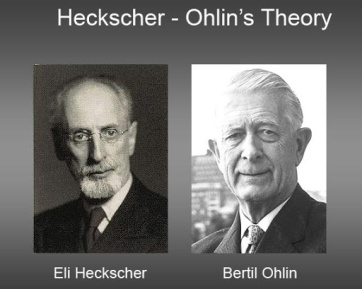In 1817 David Ricardo presented — in Principles — a theory that was meant to explain why countries trade and, based on the concept of opportunity cost, how the pattern of export and import was be ruled by countries exporting goods in which they had comparative advantage and importing goods in which they had comparatively less disadvantage. Ricardo’s theory of comparative advantage, however, didn’t explain why the comparative advantage was the way it was. In the beginning of the 20th century, two Swedish economists — Eli Heckscher and Bertil Ohlin — presented a theory/model/theorem according to which the comparative advantages arose from differences in factor endowments between countries. Countries have a comparative advantages in producing goods that use up production factors that are most abundant in the different countries. Countries would a fortiori mostly export goods that used the abundant factors of production and import goods that mostly used factors of productions that were scarce. The Heckscher-Ohlin theorem –as do the elaborations on in it by e.g. Vanek, Stolper and Samuelson — builds on a series of restrictive and unrealistic assumptions. The most critically important — beside the standard market clearing equilibrium assumptions — are (1) Countries use identical production technologies. (2) Production takes place with a constant returns to scale technology.
Topics:
Lars Pålsson Syll considers the following as important: Economics
This could be interesting, too:
Lars Pålsson Syll writes Schuldenbremse bye bye
Lars Pålsson Syll writes What’s wrong with economics — a primer
Lars Pålsson Syll writes Krigskeynesianismens återkomst
Lars Pålsson Syll writes Finding Eigenvalues and Eigenvectors (student stuff)
In 1817 David Ricardo presented — in Principles — a theory that was meant to explain why countries trade and, based on the concept of opportunity cost, how the pattern of export and import was be ruled by countries exporting goods in which they had comparative advantage and importing goods in which they had comparatively less disadvantage.
 Ricardo’s theory of comparative advantage, however, didn’t explain why the comparative advantage was the way it was. In the beginning of the 20th century, two Swedish economists — Eli Heckscher and Bertil Ohlin — presented a theory/model/theorem according to which the comparative advantages arose from differences in factor endowments between countries. Countries have a comparative advantages in producing goods that use up production factors that are most abundant in the different countries. Countries would a fortiori mostly export goods that used the abundant factors of production and import goods that mostly used factors of productions that were scarce.
Ricardo’s theory of comparative advantage, however, didn’t explain why the comparative advantage was the way it was. In the beginning of the 20th century, two Swedish economists — Eli Heckscher and Bertil Ohlin — presented a theory/model/theorem according to which the comparative advantages arose from differences in factor endowments between countries. Countries have a comparative advantages in producing goods that use up production factors that are most abundant in the different countries. Countries would a fortiori mostly export goods that used the abundant factors of production and import goods that mostly used factors of productions that were scarce.
The Heckscher-Ohlin theorem –as do the elaborations on in it by e.g. Vanek, Stolper and Samuelson — builds on a series of restrictive and unrealistic assumptions. The most critically important — beside the standard market clearing equilibrium assumptions — are
(1) Countries use identical production technologies.
(2) Production takes place with a constant returns to scale technology.
(3) Within countries the factor substitutability is more or less infinite.
(4) Factor-prices are equalised (the Stolper-Samuelson extension of the theorem).
These assumptions are, as almost all empirical testing of the theorem has shown, totally unrealistic. That is, they are empirically false.
That said, one could indeed wonder why on earth anyone should be interested in applying this theorem to real world situations. As so many other mainstream mathematical models taught to economics students today, this theorem has very little to do with the real world.
From a methodological point of view one can , of course, also wonder, how we are supposed to evaluate tests of a theorem building on known to be false assumptions. What is the point of such tests? What can those tests possibly learn us? From falsehoods anything logically follows.
